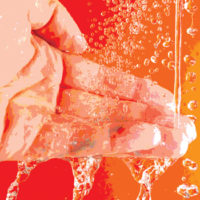Good Handwashing is Management 101

Somewhere between many and most, operators are not proud of their handwashing rates. Nor should they be. According to 19 studies conducted by Handwashing For Life there is a major gap between what operators themselves identify as a safe level and their current rate of compliance. On average the pre-training baseline compliance level was less than 50% of their own designated safe level. (For those who are confident there is no gap between safe levels and current performance, stop reading here—or go on and document your standard to be sure it survives the pace of menu additions, customer demographic changes and the general pace of growth.)
So, who is responsible to fix the hand hygiene compliance gap? According to the Food Code one could interpret that the U.S. Food and Drug Administration (FDA) is accountable for food safety based on this statement in the first paragraph of the guidelines: “The purpose of this Code is to safeguard public health and provide to consumers food that is safe, unadulterated, and honestly presented.”* While this is true and noble, it can blur operator accountability. This could be reinforced while underscoring the primary role of regulators/inspectors by having it read: The purpose of this Code is to help foodservice operators safeguard public health. The current language implies a shared responsibility between operator and regulatory agency, yet the regulatory chain of command, from the FDA down through the corps of local inspectors, is nowhere to be found in the courtroom when an operator’s feet are held to the fire by ace prosecutors.
 Time and again it has been proven that knowledge alone doesn’t change behavior, however. If knowledge was that powerful, we wouldn’t have an obesity issue in our culture. In terms of hand hygiene in food handling operations, when no one asks, no one measures, no one reports, and the result is no one washes. According to Albert Einstein, setting an example is not the main means of influencing another; it is the only means. To translate this valuable reminder into action, we suggest these five steps (Figure 1):
Time and again it has been proven that knowledge alone doesn’t change behavior, however. If knowledge was that powerful, we wouldn’t have an obesity issue in our culture. In terms of hand hygiene in food handling operations, when no one asks, no one measures, no one reports, and the result is no one washes. According to Albert Einstein, setting an example is not the main means of influencing another; it is the only means. To translate this valuable reminder into action, we suggest these five steps (Figure 1):
1. Form a Hand Hygiene Risk Assessment Team.
2. Agree on standards and achievable goals. Communicate the “why” behind them.
3. Add equipment that makes it easier for the worker to comply with the new standards.
4. Coach and train employees in good handwashing practices. Empower the staff to maintain standards, 24/7, by taking timely corrective actions.
5. Monitor progress and reward success.
We know that financial risks for those serving food increase sharply when hand hygiene is not a senior management priority. However, neither training nor science creates sustainable gains in handwashing compliance without a handwashing management reporting system. One way the food company’s management can improve compliance is to establish a temporary cross-functional group of internal talent to assess current hand hygiene practices according to risk criteria. The customer base, the quality of the workforce, the span of management control and the range of facilities can all be considered within this framework. Here, we’ll focus on why Operations should lead such a Hand Hygiene Risk Assessment Team within the restaurant environment and discuss how this strategy can help managers better measure handwashing compliance.
From Science to Compliance
Without measurement, without decision support information, handwashing is easily trivialized and continuous improvement programs never get started. Handwashing remains seen as a nonproductive use of time and a drain on productivity numbers that are often the source of employee incentives. The restaurant culture understands that what is valued by headquarters is tracked, often by shift, daily or weekly.
 Converting the growing bank of knowledge surrounding bacterial foodborne outbreaks into preventive measures for restauranteurs, food processors and retailers has traditionally been the domain of QA teams. Keeping up on the mutations of the viral world is another task that falls squarely on these scientists, as well as converting the scientific facts into operational interventions. Unfortunately, 1 + 2 + 3 is not adding up to good hand hygiene behaviors. As shown in Figure 2, changing behavior doesn’t happen in a vacuum.
Converting the growing bank of knowledge surrounding bacterial foodborne outbreaks into preventive measures for restauranteurs, food processors and retailers has traditionally been the domain of QA teams. Keeping up on the mutations of the viral world is another task that falls squarely on these scientists, as well as converting the scientific facts into operational interventions. Unfortunately, 1 + 2 + 3 is not adding up to good hand hygiene behaviors. As shown in Figure 2, changing behavior doesn’t happen in a vacuum.
While this is bound to seem trivial to some, quality assurance is the role of Quality Assurance, whose primary function is to verify that food safety and quality assurance standards are met. QA monitors controlled systems. On the other hand, quality control falls under the jurisdiction of Operations, whose staff implements actual controls for food storage, preparation and service. Operations typically focuses on the indicators of profitability, service and growth.
So, who is in charge of food safety and hand hygiene? Operations! Nothing tends to happen in a restaurant until Operations understands, buys in and motivates their on-site teams through a controlled series of implementation steps. That’s how it works with menu additions, new uniforms and a myriad of Marketing, Training and Human Resource programs.
The Person-In-Charge (PIC) concept has been advancement in the restaurant’s ability to control some food safety factors like maintaining temperature logs and enforcing the “ill employee” policy. The PIC is not part of QA. He or she is a member of the Operations chain of command. The restaurant’s responsibility as per the Model Food Code is to “designate a person in charge and shall ensure that a person in charge is present at the food establishment during all hours of operation.” In the area of hand hygiene, the PIC has nothing to monitor other than an occasional glance at the handsink (i.e., dry or wet?). But Operations has the experience and the know-how to actually change handwashing behaviors. The solution is seeded in their series of annual projects requiring change.
Operations can advocate more effectively for the formation of a temporary Hand Hygiene Risk Assessment Team to spur changes in personnel handwashing behavior. The team should include professionals from the following departments: Risk Management or Finance, Quality Assurance (QA), Purchasing, Training, and Operations. This team sets approximate standards for the quality and frequency for handwashing after reviewing their restaurant’s or processing facility’s food handling practices. In the initial phases, the multidisciplined team can expect to be challenged by those who feel this is a task purely for QA or Training. Both have important roles but by appointing Operations to lead the team, the implementation stage will be accelerated and more effectively facilitated.
We suggest selecting one of the best-executed menu additions experienced by the team members in their respective roles. This becomes the center of discussion at one of the early team meetings, listing the steps and relating them to the hand hygiene challenges they face. When a new menu item is introduced it is wrapped in an intense research program followed by test kitchen development with near-seamless input from the science of Quality Assurance. Once aligned, Operations picks up the item and works it into the realities of practical application: into equipment, menu, facilities, customer base, local management skills and workforce quality. The new item is then rolled out to a region or more. Results versus standards are monitored. Cost/value analysis is verified. Positive ratios further expand the new item.
Implementing Handwashing Management 101
When the Hand Hygiene Risk Assessment team’s analysis is complete, they can issue an internal management statement summarizing the corporate risk, which is the foundation for further action. This Hand Hygiene Risk statement should have a headline of not more than 10 words that covers the reality and takes into account the culture and organizational structure of the company. It should include a statement such as: “Our risk is (high, moderately high, or low) based on our team’s assessment of current conditions and hand hygiene practices.” The statement should include the risk-based criteria used, for example:
1. At-Risk Customer Ratio, and Ill Customer Factor
2. Menu
3. Food Handling, Ready-to-Eat (RTE) Factors, Process Control
4. Facility/Equipment Considerations
5. Worker Quality, Health, Training and Turnover
6. Management/Employee Motivation and Control
This is followed by a two-page executive summary that includes a recommended solution, the building of a working model and budgets to accompany each phase. Agreed success moves the model to a multi-restaurant scale of three to five units. Also included is a verbal expression of the ongoing tension between productivity and handwashing along with two cautions:
1. Beware, measurement of direct costs can eclipse the bigger but less measurable indirect cost savings, like reduced absenteeism, insurance premiums, brand value, image and the direct costs of foodborne outbreaks.
2. Beware, does productivity trump safety here at ABC Diner?
The solution is written down, shared and implemented with the rigor and follow-up of a new menu item. Now armed with a system, Quality Assurance helps Operations achieve their quality goals by periodic monitoring. The Hand Hygiene Assessment Team disbands. Handwashing compliance becomes a line in periodic reports up through the Operation’s organization to the company’s executive management.
Risk Insurance Pays
Best practice, safe level handwashing and sanitizing will cost more. Adding up soap, paper, sanitizer, employee time and depreciation costs for more handsinks might add up to a $ 0.10 handwash. Whatever it takes to achieve your hand hygiene safe levels must be worth considering as serving good food is first about serving safe food. As the risk will never be zero, insurance has its place in managing this risk.
A multi-unit operation always has a lot of experience in how problems are solved. Their confidence building and decision making process will first reflect values rather than budget limitations. It isn’t the budget that keeps handwashing issues unresolved; it is the lack of decision support information. Good management is starved by the handwashing information famine. They don’t know the current gaps and how little it actually costs to substantially reduce the risk of an outbreak. If there ever was a silver bullet for this issue it is Handwashing Management 101.
Jim Mann is the founder and Executive Director of the Handwashing For Life Institute and the Handwashing Leadership Forum (www.handwashingforlife.com). His work to reduce the risk of foodborne illness spans a career from deli and cafeteria experience to work as a chemist. He formulated leading brands in skin care, surface disinfection, pest control and foodservice cleaner systems. His work has been as global as the worldwide war on virus and bacteria, working on six continents while living in three. Jim is a recipient of NSF’s prestigious Lifetime Achievement Award. He can be reached at jmann@handwashingforlife.com.
* Editor’s note: References to the Model Food Code can be found at www.handwashingforlife.com/2005_food_code_hand_hygiene_version.
Looking for a reprint of this article?
From high-res PDFs to custom plaques, order your copy today!






